Al Muntazah Supermarket: Comprehensive Marketing Environment Analysis
VerifiedAdded on 2019/09/30
|9
|1445
|320
Report
AI Summary
This report provides a comprehensive marketing environment analysis for Al Muntazah Supermarket, a major supermarket chain in Bahrain. The analysis begins with an overview of the company, including its history and commitment to Islamic principles. The internal environment is assessed using the 5Ms framework (Manpower, Machinery, Money, Markets, Materials). The micro-environment is evaluated using Porter's Five Forces, highlighting the competitive landscape and supplier/buyer power dynamics. The macro-environment is examined through PEST analysis (Political, Economic, Social, and Technological factors), identifying key trends and their potential impact. A sales plan for the next five years is presented, including projected growth and investment strategies. The report concludes with an examination of how macro factors influence the organization and its customers, considering political, economic, social, and technological impacts on buying behavior and customer expectations.
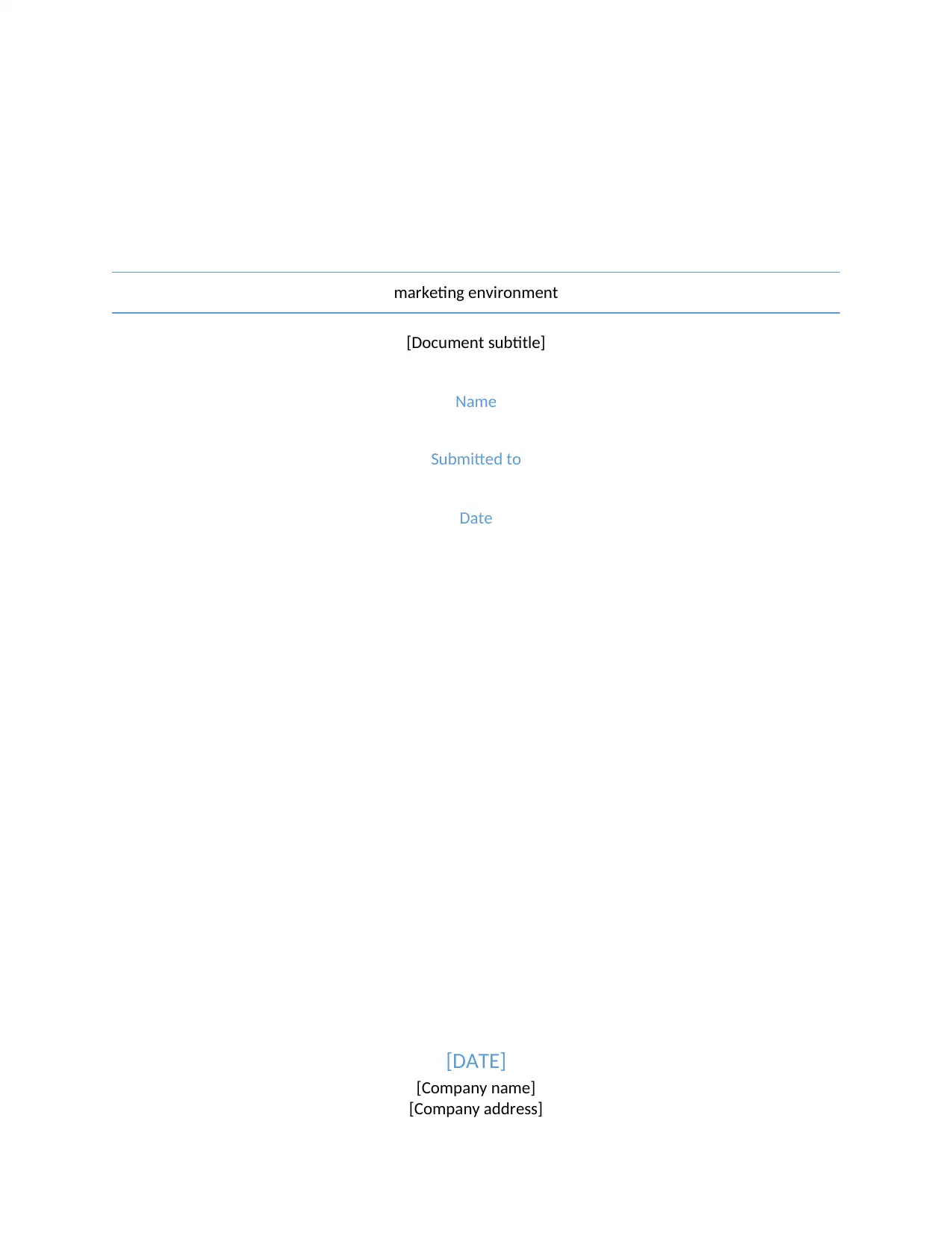
marketing environment
[Document subtitle]
Name
Submitted to
Date
[DATE]
[Company name]
[Company address]
[Document subtitle]
Name
Submitted to
Date
[DATE]
[Company name]
[Company address]
Paraphrase This Document
Need a fresh take? Get an instant paraphrase of this document with our AI Paraphraser
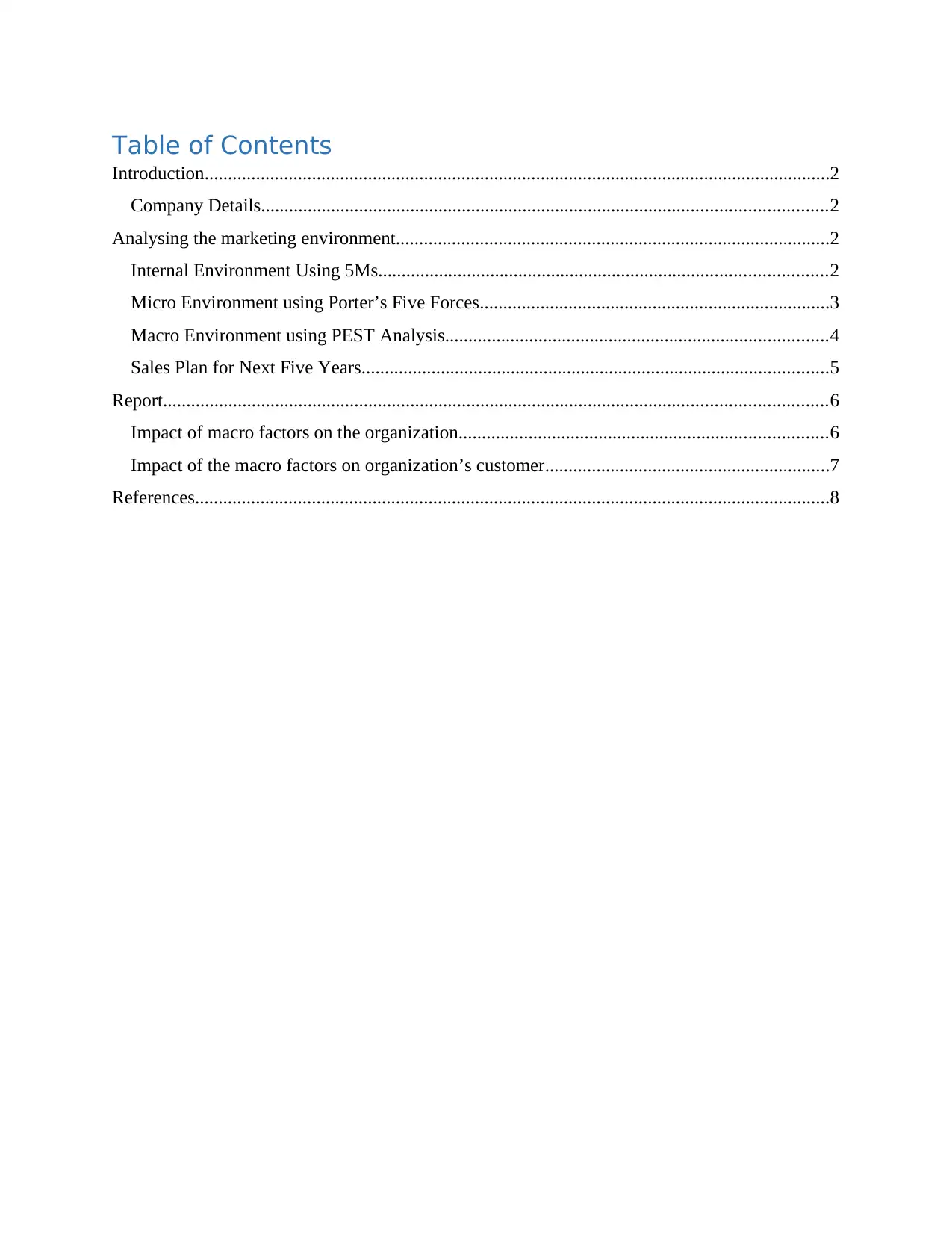
Table of Contents
Introduction......................................................................................................................................2
Company Details.........................................................................................................................2
Analysing the marketing environment.............................................................................................2
Internal Environment Using 5Ms................................................................................................2
Micro Environment using Porter’s Five Forces...........................................................................3
Macro Environment using PEST Analysis..................................................................................4
Sales Plan for Next Five Years....................................................................................................5
Report..............................................................................................................................................6
Impact of macro factors on the organization...............................................................................6
Impact of the macro factors on organization’s customer.............................................................7
References........................................................................................................................................8
Introduction......................................................................................................................................2
Company Details.........................................................................................................................2
Analysing the marketing environment.............................................................................................2
Internal Environment Using 5Ms................................................................................................2
Micro Environment using Porter’s Five Forces...........................................................................3
Macro Environment using PEST Analysis..................................................................................4
Sales Plan for Next Five Years....................................................................................................5
Report..............................................................................................................................................6
Impact of macro factors on the organization...............................................................................6
Impact of the macro factors on organization’s customer.............................................................7
References........................................................................................................................................8
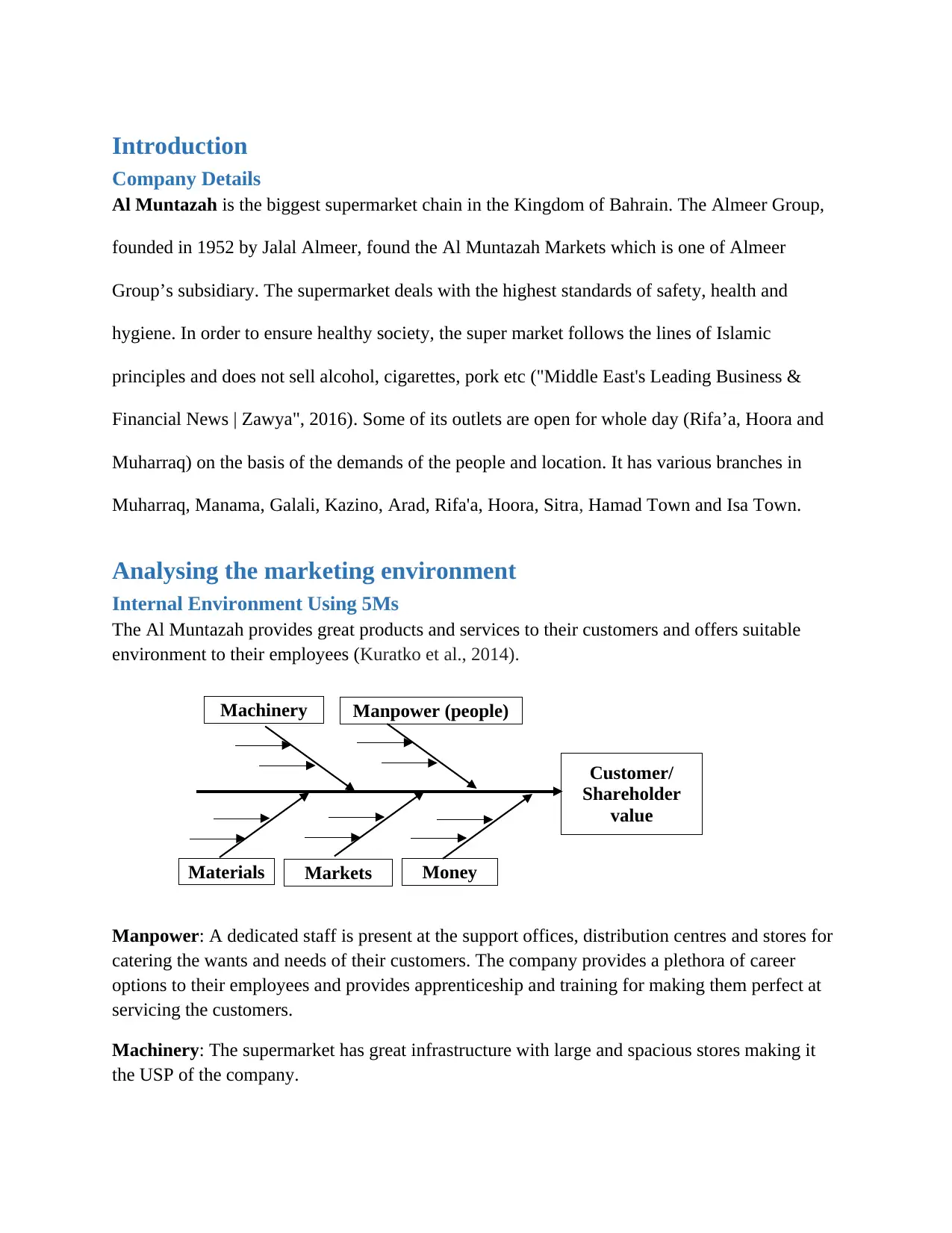
Customer/
Shareholder
value
Machinery Manpower (people)
MarketsMaterials Money
Introduction
Company Details
Al Muntazah is the biggest supermarket chain in the Kingdom of Bahrain. The Almeer Group,
founded in 1952 by Jalal Almeer, found the Al Muntazah Markets which is one of Almeer
Group’s subsidiary. The supermarket deals with the highest standards of safety, health and
hygiene. In order to ensure healthy society, the super market follows the lines of Islamic
principles and does not sell alcohol, cigarettes, pork etc ("Middle East's Leading Business &
Financial News | Zawya", 2016). Some of its outlets are open for whole day (Rifa’a, Hoora and
Muharraq) on the basis of the demands of the people and location. It has various branches in
Muharraq, Manama, Galali, Kazino, Arad, Rifa'a, Hoora, Sitra, Hamad Town and Isa Town.
Analysing the marketing environment
Internal Environment Using 5Ms
The Al Muntazah provides great products and services to their customers and offers suitable
environment to their employees (Kuratko et al., 2014).
Manpower: A dedicated staff is present at the support offices, distribution centres and stores for
catering the wants and needs of their customers. The company provides a plethora of career
options to their employees and provides apprenticeship and training for making them perfect at
servicing the customers.
Machinery: The supermarket has great infrastructure with large and spacious stores making it
the USP of the company.
Shareholder
value
Machinery Manpower (people)
MarketsMaterials Money
Introduction
Company Details
Al Muntazah is the biggest supermarket chain in the Kingdom of Bahrain. The Almeer Group,
founded in 1952 by Jalal Almeer, found the Al Muntazah Markets which is one of Almeer
Group’s subsidiary. The supermarket deals with the highest standards of safety, health and
hygiene. In order to ensure healthy society, the super market follows the lines of Islamic
principles and does not sell alcohol, cigarettes, pork etc ("Middle East's Leading Business &
Financial News | Zawya", 2016). Some of its outlets are open for whole day (Rifa’a, Hoora and
Muharraq) on the basis of the demands of the people and location. It has various branches in
Muharraq, Manama, Galali, Kazino, Arad, Rifa'a, Hoora, Sitra, Hamad Town and Isa Town.
Analysing the marketing environment
Internal Environment Using 5Ms
The Al Muntazah provides great products and services to their customers and offers suitable
environment to their employees (Kuratko et al., 2014).
Manpower: A dedicated staff is present at the support offices, distribution centres and stores for
catering the wants and needs of their customers. The company provides a plethora of career
options to their employees and provides apprenticeship and training for making them perfect at
servicing the customers.
Machinery: The supermarket has great infrastructure with large and spacious stores making it
the USP of the company.
⊘ This is a preview!⊘
Do you want full access?
Subscribe today to unlock all pages.

Trusted by 1+ million students worldwide
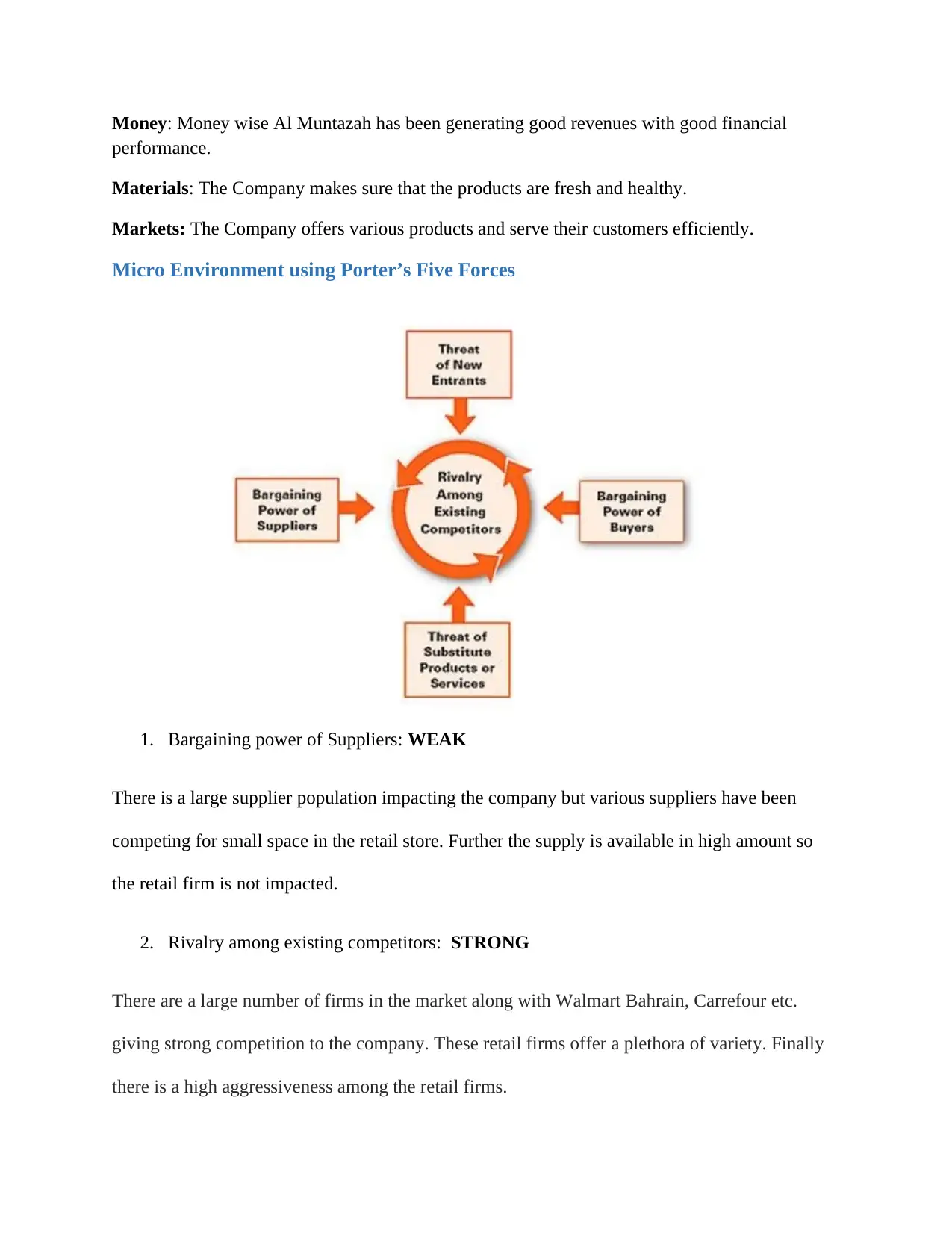
Money: Money wise Al Muntazah has been generating good revenues with good financial
performance.
Materials: The Company makes sure that the products are fresh and healthy.
Markets: The Company offers various products and serve their customers efficiently.
Micro Environment using Porter’s Five Forces
1. Bargaining power of Suppliers: WEAK
There is a large supplier population impacting the company but various suppliers have been
competing for small space in the retail store. Further the supply is available in high amount so
the retail firm is not impacted.
2. Rivalry among existing competitors: STRONG
There are a large number of firms in the market along with Walmart Bahrain, Carrefour etc.
giving strong competition to the company. These retail firms offer a plethora of variety. Finally
there is a high aggressiveness among the retail firms.
performance.
Materials: The Company makes sure that the products are fresh and healthy.
Markets: The Company offers various products and serve their customers efficiently.
Micro Environment using Porter’s Five Forces
1. Bargaining power of Suppliers: WEAK
There is a large supplier population impacting the company but various suppliers have been
competing for small space in the retail store. Further the supply is available in high amount so
the retail firm is not impacted.
2. Rivalry among existing competitors: STRONG
There are a large number of firms in the market along with Walmart Bahrain, Carrefour etc.
giving strong competition to the company. These retail firms offer a plethora of variety. Finally
there is a high aggressiveness among the retail firms.
Paraphrase This Document
Need a fresh take? Get an instant paraphrase of this document with our AI Paraphraser
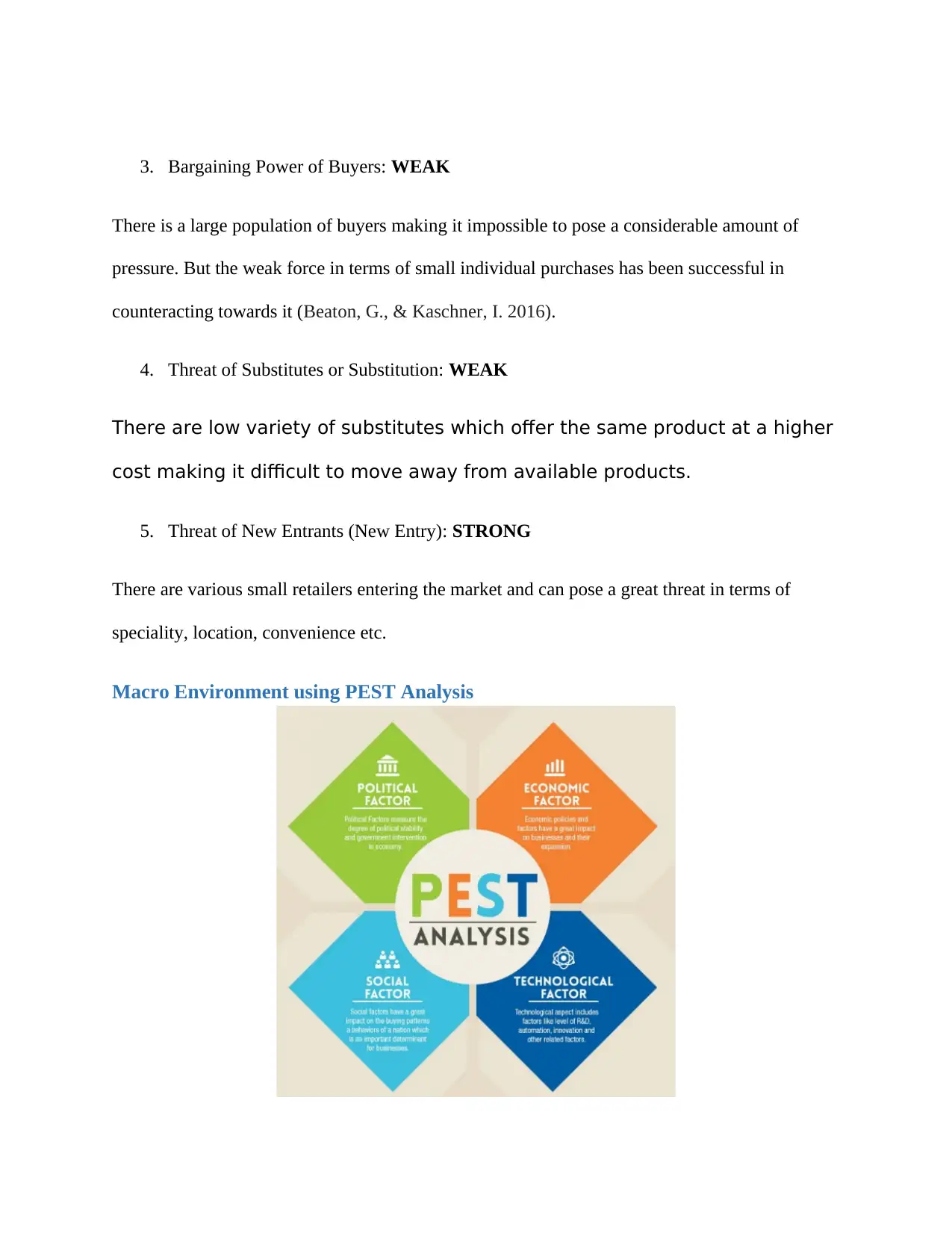
3. Bargaining Power of Buyers: WEAK
There is a large population of buyers making it impossible to pose a considerable amount of
pressure. But the weak force in terms of small individual purchases has been successful in
counteracting towards it (Beaton, G., & Kaschner, I. 2016).
4. Threat of Substitutes or Substitution: WEAK
There are low variety of substitutes which offer the same product at a higher
cost making it difficult to move away from available products.
5. Threat of New Entrants (New Entry): STRONG
There are various small retailers entering the market and can pose a great threat in terms of
speciality, location, convenience etc.
Macro Environment using PEST Analysis
There is a large population of buyers making it impossible to pose a considerable amount of
pressure. But the weak force in terms of small individual purchases has been successful in
counteracting towards it (Beaton, G., & Kaschner, I. 2016).
4. Threat of Substitutes or Substitution: WEAK
There are low variety of substitutes which offer the same product at a higher
cost making it difficult to move away from available products.
5. Threat of New Entrants (New Entry): STRONG
There are various small retailers entering the market and can pose a great threat in terms of
speciality, location, convenience etc.
Macro Environment using PEST Analysis
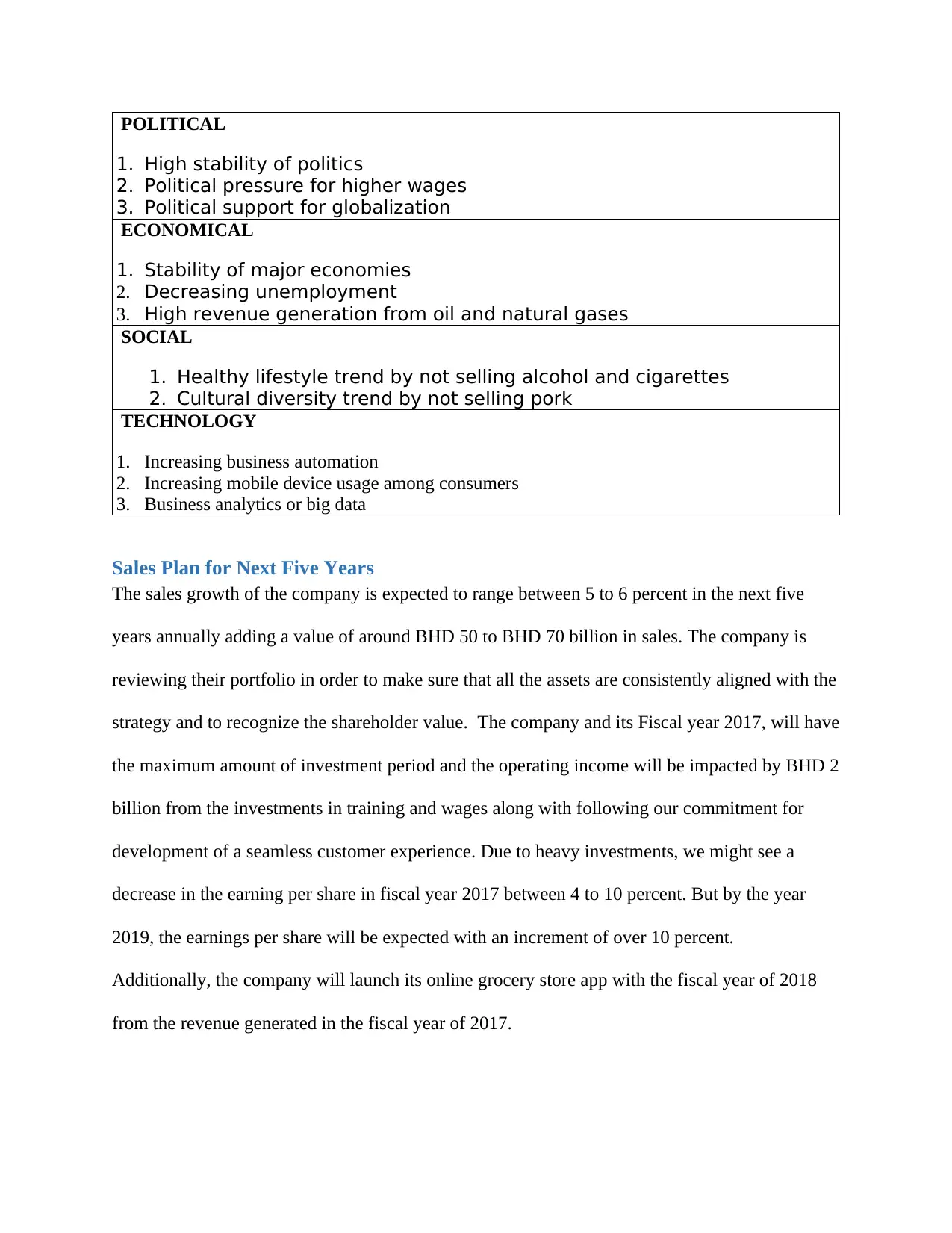
POLITICAL
1. High stability of politics
2. Political pressure for higher wages
3. Political support for globalization
ECONOMICAL
1. Stability of major economies
2. Decreasing unemployment
3. High revenue generation from oil and natural gases
SOCIAL
1. Healthy lifestyle trend by not selling alcohol and cigarettes
2. Cultural diversity trend by not selling pork
TECHNOLOGY
1. Increasing business automation
2. Increasing mobile device usage among consumers
3. Business analytics or big data
Sales Plan for Next Five Years
The sales growth of the company is expected to range between 5 to 6 percent in the next five
years annually adding a value of around BHD 50 to BHD 70 billion in sales. The company is
reviewing their portfolio in order to make sure that all the assets are consistently aligned with the
strategy and to recognize the shareholder value. The company and its Fiscal year 2017, will have
the maximum amount of investment period and the operating income will be impacted by BHD 2
billion from the investments in training and wages along with following our commitment for
development of a seamless customer experience. Due to heavy investments, we might see a
decrease in the earning per share in fiscal year 2017 between 4 to 10 percent. But by the year
2019, the earnings per share will be expected with an increment of over 10 percent.
Additionally, the company will launch its online grocery store app with the fiscal year of 2018
from the revenue generated in the fiscal year of 2017.
1. High stability of politics
2. Political pressure for higher wages
3. Political support for globalization
ECONOMICAL
1. Stability of major economies
2. Decreasing unemployment
3. High revenue generation from oil and natural gases
SOCIAL
1. Healthy lifestyle trend by not selling alcohol and cigarettes
2. Cultural diversity trend by not selling pork
TECHNOLOGY
1. Increasing business automation
2. Increasing mobile device usage among consumers
3. Business analytics or big data
Sales Plan for Next Five Years
The sales growth of the company is expected to range between 5 to 6 percent in the next five
years annually adding a value of around BHD 50 to BHD 70 billion in sales. The company is
reviewing their portfolio in order to make sure that all the assets are consistently aligned with the
strategy and to recognize the shareholder value. The company and its Fiscal year 2017, will have
the maximum amount of investment period and the operating income will be impacted by BHD 2
billion from the investments in training and wages along with following our commitment for
development of a seamless customer experience. Due to heavy investments, we might see a
decrease in the earning per share in fiscal year 2017 between 4 to 10 percent. But by the year
2019, the earnings per share will be expected with an increment of over 10 percent.
Additionally, the company will launch its online grocery store app with the fiscal year of 2018
from the revenue generated in the fiscal year of 2017.
⊘ This is a preview!⊘
Do you want full access?
Subscribe today to unlock all pages.

Trusted by 1+ million students worldwide
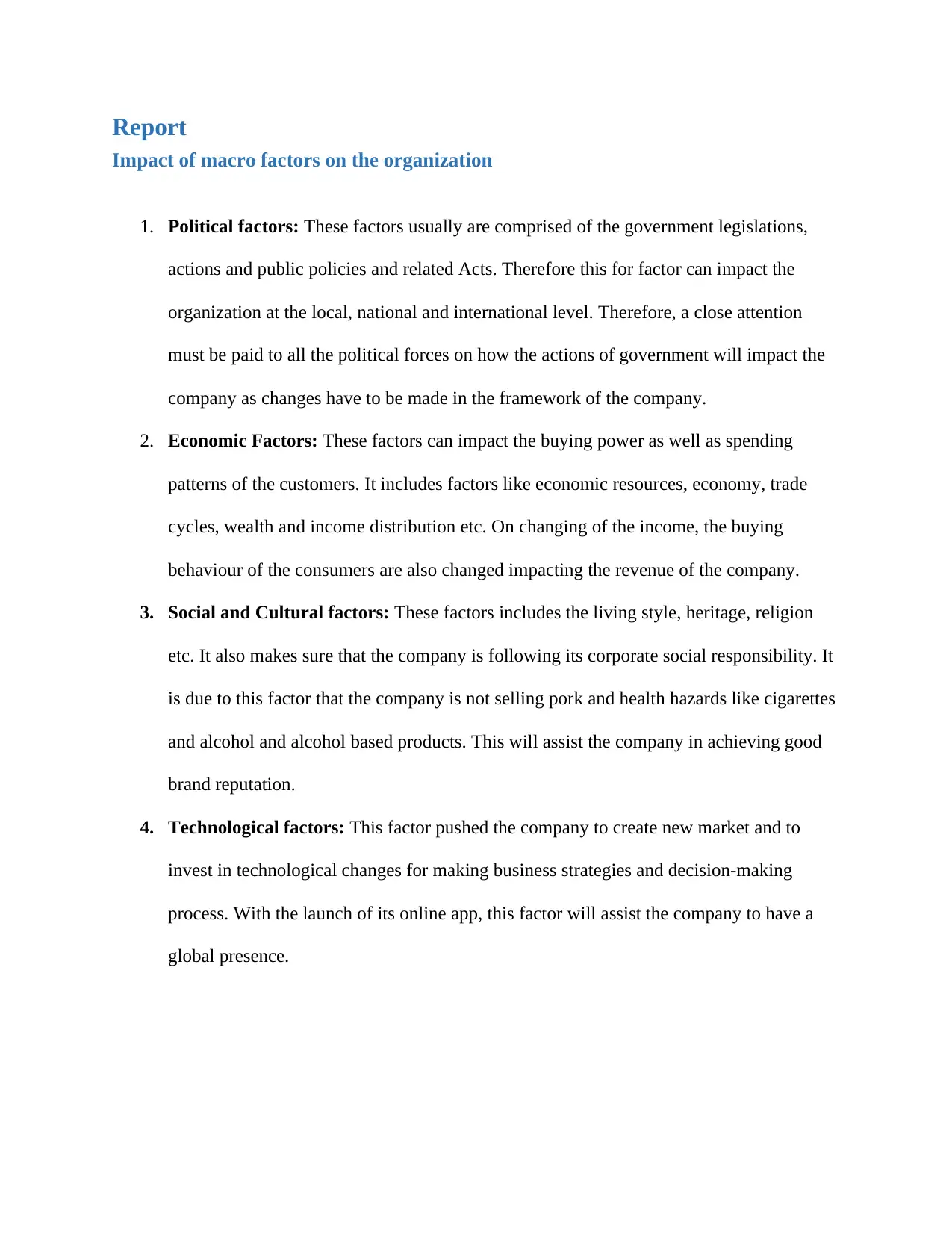
Report
Impact of macro factors on the organization
1. Political factors: These factors usually are comprised of the government legislations,
actions and public policies and related Acts. Therefore this for factor can impact the
organization at the local, national and international level. Therefore, a close attention
must be paid to all the political forces on how the actions of government will impact the
company as changes have to be made in the framework of the company.
2. Economic Factors: These factors can impact the buying power as well as spending
patterns of the customers. It includes factors like economic resources, economy, trade
cycles, wealth and income distribution etc. On changing of the income, the buying
behaviour of the consumers are also changed impacting the revenue of the company.
3. Social and Cultural factors: These factors includes the living style, heritage, religion
etc. It also makes sure that the company is following its corporate social responsibility. It
is due to this factor that the company is not selling pork and health hazards like cigarettes
and alcohol and alcohol based products. This will assist the company in achieving good
brand reputation.
4. Technological factors: This factor pushed the company to create new market and to
invest in technological changes for making business strategies and decision-making
process. With the launch of its online app, this factor will assist the company to have a
global presence.
Impact of macro factors on the organization
1. Political factors: These factors usually are comprised of the government legislations,
actions and public policies and related Acts. Therefore this for factor can impact the
organization at the local, national and international level. Therefore, a close attention
must be paid to all the political forces on how the actions of government will impact the
company as changes have to be made in the framework of the company.
2. Economic Factors: These factors can impact the buying power as well as spending
patterns of the customers. It includes factors like economic resources, economy, trade
cycles, wealth and income distribution etc. On changing of the income, the buying
behaviour of the consumers are also changed impacting the revenue of the company.
3. Social and Cultural factors: These factors includes the living style, heritage, religion
etc. It also makes sure that the company is following its corporate social responsibility. It
is due to this factor that the company is not selling pork and health hazards like cigarettes
and alcohol and alcohol based products. This will assist the company in achieving good
brand reputation.
4. Technological factors: This factor pushed the company to create new market and to
invest in technological changes for making business strategies and decision-making
process. With the launch of its online app, this factor will assist the company to have a
global presence.
Paraphrase This Document
Need a fresh take? Get an instant paraphrase of this document with our AI Paraphraser
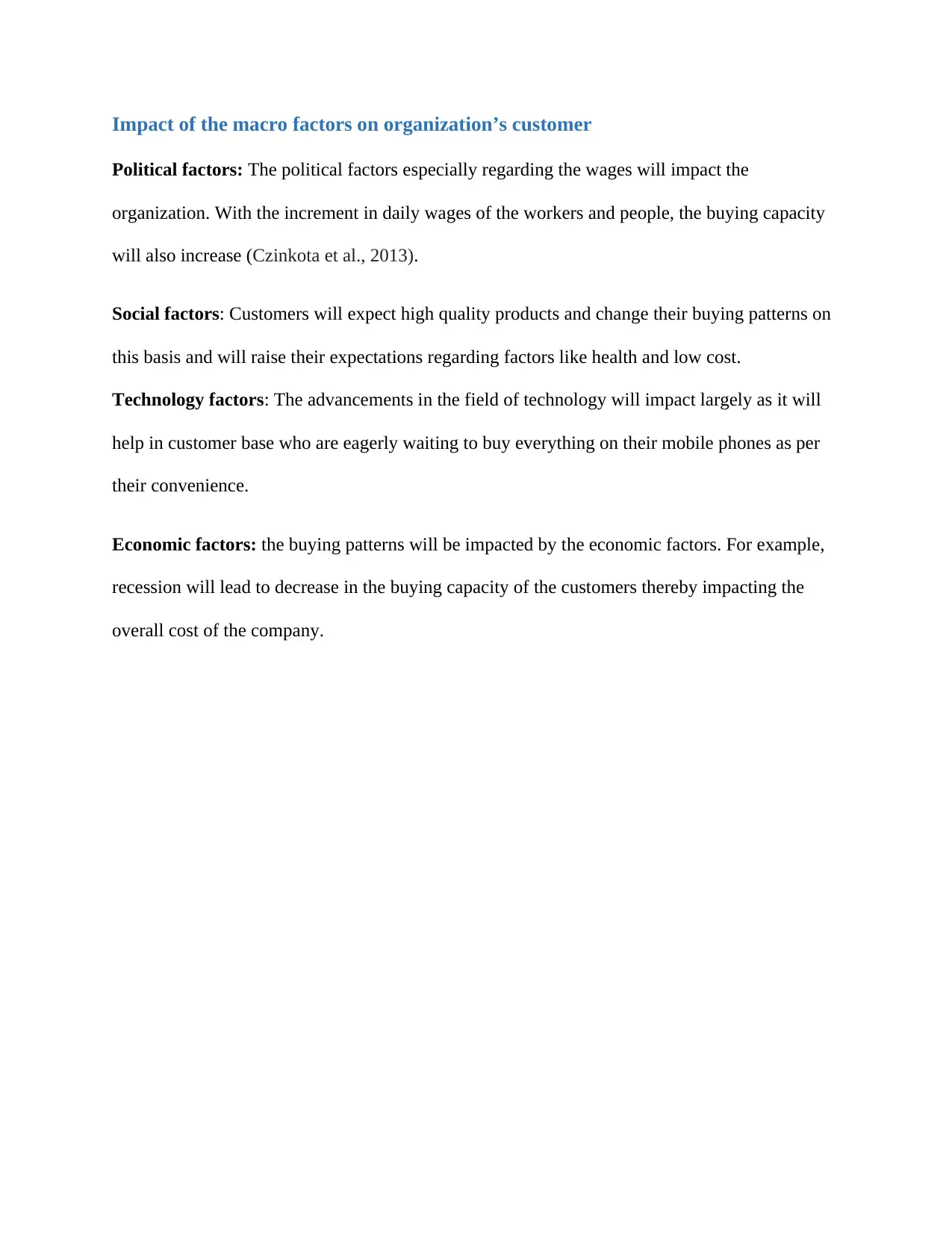
Impact of the macro factors on organization’s customer
Political factors: The political factors especially regarding the wages will impact the
organization. With the increment in daily wages of the workers and people, the buying capacity
will also increase (Czinkota et al., 2013).
Social factors: Customers will expect high quality products and change their buying patterns on
this basis and will raise their expectations regarding factors like health and low cost.
Technology factors: The advancements in the field of technology will impact largely as it will
help in customer base who are eagerly waiting to buy everything on their mobile phones as per
their convenience.
Economic factors: the buying patterns will be impacted by the economic factors. For example,
recession will lead to decrease in the buying capacity of the customers thereby impacting the
overall cost of the company.
Political factors: The political factors especially regarding the wages will impact the
organization. With the increment in daily wages of the workers and people, the buying capacity
will also increase (Czinkota et al., 2013).
Social factors: Customers will expect high quality products and change their buying patterns on
this basis and will raise their expectations regarding factors like health and low cost.
Technology factors: The advancements in the field of technology will impact largely as it will
help in customer base who are eagerly waiting to buy everything on their mobile phones as per
their convenience.
Economic factors: the buying patterns will be impacted by the economic factors. For example,
recession will lead to decrease in the buying capacity of the customers thereby impacting the
overall cost of the company.
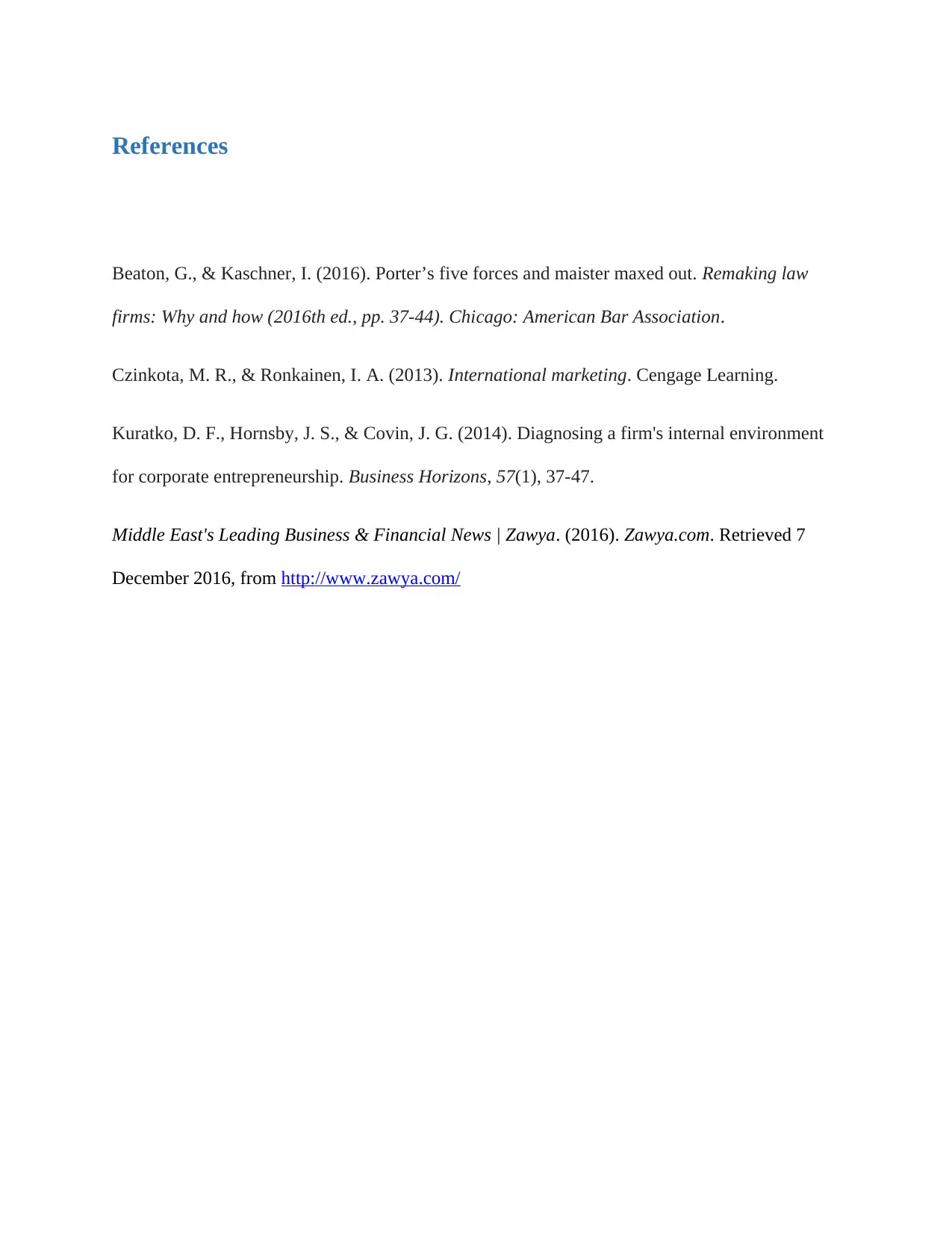
References
Beaton, G., & Kaschner, I. (2016). Porter’s five forces and maister maxed out. Remaking law
firms: Why and how (2016th ed., pp. 37-44). Chicago: American Bar Association.
Czinkota, M. R., & Ronkainen, I. A. (2013). International marketing. Cengage Learning.
Kuratko, D. F., Hornsby, J. S., & Covin, J. G. (2014). Diagnosing a firm's internal environment
for corporate entrepreneurship. Business Horizons, 57(1), 37-47.
Middle East's Leading Business & Financial News | Zawya. (2016). Zawya.com. Retrieved 7
December 2016, from http://www.zawya.com/
Beaton, G., & Kaschner, I. (2016). Porter’s five forces and maister maxed out. Remaking law
firms: Why and how (2016th ed., pp. 37-44). Chicago: American Bar Association.
Czinkota, M. R., & Ronkainen, I. A. (2013). International marketing. Cengage Learning.
Kuratko, D. F., Hornsby, J. S., & Covin, J. G. (2014). Diagnosing a firm's internal environment
for corporate entrepreneurship. Business Horizons, 57(1), 37-47.
Middle East's Leading Business & Financial News | Zawya. (2016). Zawya.com. Retrieved 7
December 2016, from http://www.zawya.com/
⊘ This is a preview!⊘
Do you want full access?
Subscribe today to unlock all pages.

Trusted by 1+ million students worldwide
1 out of 9
Related Documents
Your All-in-One AI-Powered Toolkit for Academic Success.
+13062052269
info@desklib.com
Available 24*7 on WhatsApp / Email
![[object Object]](/_next/static/media/star-bottom.7253800d.svg)
Unlock your academic potential
Copyright © 2020–2025 A2Z Services. All Rights Reserved. Developed and managed by ZUCOL.




